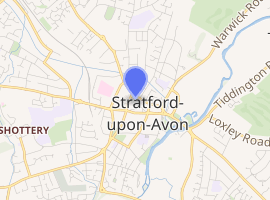White Lion Inn, Stratford-upon-Avon
The White Lion Inn was a public house located in Henley Street, Stratford-upon-Avon, England, an example of Elizabethan architecture that first appears in historical records in 1591. The building was mentioned by both Harriet Beecher Stowe and Rupert Graves.
| The White Lion Inn | |
|---|---|

| |
| General information | |
| Architectural style | Black and white timber frame |
| Town or city | Stratford-upon-Avon |
| Country | England |
| Coordinates | 52°11′39″N 1°42′31″W |
| Completed | 1541 |
History
The earliest references to the White Lion Inn date to 1591.[1] The original building, which was at nos, 16, 17, 18 Henley Street was demolished and rebuilt in 1753 making it one of the largest inns on the Holyhead Road by its landlord at the time, John Payton.[2]
In its heyday the White Lion Inn was considered to be on a par with some of the better eating establishments in London and was reported to offer “a bill of fare equal to that of the Piazza Coffee House”. In 1785 members of the household of Louis XVI of France stayed here and in 1806 the Prince Regent (later George IV of the United Kingdom) stayed in specially prepared apartments. During the English Civil War the building was taken over by parliamentary soldiers.
The Garrick Jubilee of Shakespearean performances in 1769 came about because of an idea by John Payton, the landlord of the White Lion. Payton was a genuine Shakespeare enthusiast and a friend of the Shakespearian editor George Alexander Steevens. In 1768, when Steevens was staying at the White Lion, Payton invited some of his friends from the town corporation to meet him. The new Town Hall had just been finished and it was regretted "that an open niche had been constructed on the north side of it without any prospect of obtaining a statue or even a bust to grace it". A statue of Shakespeare was suggested as the most fitting adornment and Steevens offered to persuade David Garrick to present one. The corporation elaborated on his suggestions by offering to confer on Garrick the freedom of the borough in a box made from the wood of Shakespeare's mulberry tree. This led Garrick not only to present a statue of Shakespeare, but to come down and organize a Shakespearian festival at Stratford.[3]
The remaining portions of the building were added to the English Heritage list of protected buildings in 1994.[4]
Witchcraft and Wizardology Museum
The Witchcraft and Wizardology Museum at 21 Henley Street is a privately amassed collection of ephemera and articles that reflect on the history of Witchcraft and Wizardology from pre-Christian times to the present day. Concentrating on providing a fair and balanced viewpoint that remains family orientated whilst retaining the darker and more sinister aspects of human sacrifice and the Knights Templar link to the craft.
Amassed over 40 years, this collection of articles, rituals and ephemera challenges the accepted stereotypes of witches whilst avoiding the standard "everything behind a glass case" approach.[5] Encouraging a hands on approach to the more traditional aspects of witchcraft it provides a focal point for discussion and those seeking knowledge in a non threatening environment.[6][7]
Regularly described as one of the most haunted buildings in the country by the owner[8] and visited by paranormal investigators, parapsychology groups and ghost hunters,[9][10] it continues to offer a glimpse into the world of the supernatural and the unknown.[11]
References
- Campbell & Quinn (1966). The Reader's Encyclopedia of Shakespeare. Crowell.
- Fox (1953). The borough town of Stratford-upon-Avon. Corporation of Stratford-upon-Avon.
- "The borough of Stratford-upon-Avon Shakespearean festivals and theatres". British History Online. Retrieved 9 March 2009.
- "White Lion Inn, Stratford-upon-Avon". Heritage Gateway.
- "Creaky Cauldron - Wyrd Museum and Henley Street Theatre, Stratford upon Avon". Warwickshire County Council. Retrieved 9 March 2009.
- "Dr Thaddeus Bombay and his Museum of Wizardology". IdeasForTheKids.com. Retrieved 9 March 2009.
- "Day Trip from London to Stratford-upon-Avon". Disabled World. Retrieved 9 March 2009.
- "City ghost walks and tours". enjoyEngland. Retrieved 9 March 2009.
- "Ghost Hunting Events - The Creaky Cauldron". entitystore.com. Retrieved 11 March 2009.
- "The Creaky Cauldron (cached)". Ghostfinder Paranormal Society UK. Retrieved 11 March 2009.
- "Museum failed to be truly magical". Birmingham Mail. Retrieved 9 March 2009.